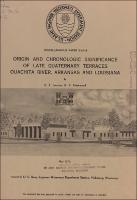Please use this identifier to cite or link to this item:
https://hdl.handle.net/11681/20839| Title: | Origin and chronologic significance of late Quaternary terraces, Ouachita River, Arkansas and Louisiana |
| Authors: | Saucier, Roger T. Fleetwood, Arthur R. |
| Keywords: | Geology Geologic features Stratigraphy Arkansas Louisiana Ouachita River basin |
| Publisher: | U.S. Army Engineer Waterways Experiment Station. Engineer Research and Development Center (U.S.) |
| Description: | Miscellaneous Paper Abstract: Efforts to differentiate Quaternary alluvial deposits along the Ouachita River between Camden, Arkansas, and Monroe, Louisiana, according to environments of deposition have indicated the presence of five fluvial terraces, three of which are considered to comprise the Deweyville terrace sequence. This sequence, lying stratigraphically between the Prairie terrace and the Holocene floodplain, can be distinguished partly by large meander scars that are characteristic of the terrace where it is present on several Coastal Plain streams. Previous investigations have established the age of the Deweyville terraces as being between 13,000 and 30,000 years before present; however, opinions vary regarding mode of origin. Morphologic characteristics of and stratigraphic relationships between the terraces along the Ouachita River indicate that a close causal relationship existed between the terraces and major episodes of aggradation and degradation in the Mississippi alluvial valley, but changes in hydraulic regimen brought about by climatic change were also significant. The chronological sequence indicated for the Ouachita Valley includes (A.) deposition of the Prairie terrace formation during the Sangamon Interglacial Stage, (B.) primary valley degradation and deep stream entrenchment during waxing Early Wisconsin glaciation, (C.) alluviation during waning Early Wisconsin glaciation with maximum valley aggradation occurring during the Farmdalian Substage, (D.) secondary valley degradation and moderate entrenchment during waxing Late Wisconsin glaciation, and (E.) alluviation and valley aggradation during waning Late Wisconsin glaciation and continuing into the Holocene. Rapid deposition of glacial out wash in the Mississippi Valley, including the development of an alluvial cone by the Arkansas River, resulted in the damming of the lower end of the Ouachita Valley during the Farmdalian Substage. A 500- to 700-sq-mile perennial lake, called Lake Monroe, was created by the damming: shoreline features and lacustrine plain remnants of the lake comprise what is recognized as the highest and intermediate Deweyville terraces. The lowest Deweyville terrace was created subsequently during a period of waxing glaciation and valley entrenchment and under the influence of a pluvial climate. Empirical equations suggest that stream discharges were 6 or 7 times greater than present and that precipitation was more than twice.that of present during this period. |
| Rights: | Approved for public release; distribution is unlimited. |
| URI: | http://hdl.handle.net/11681/20839 |
| Appears in Collections: | Miscellaneous Paper |
Files in This Item:
| File | Description | Size | Format | |
|---|---|---|---|---|
| MP-S-70-16.pdf | 17.72 MB | Adobe PDF |  View/Open |